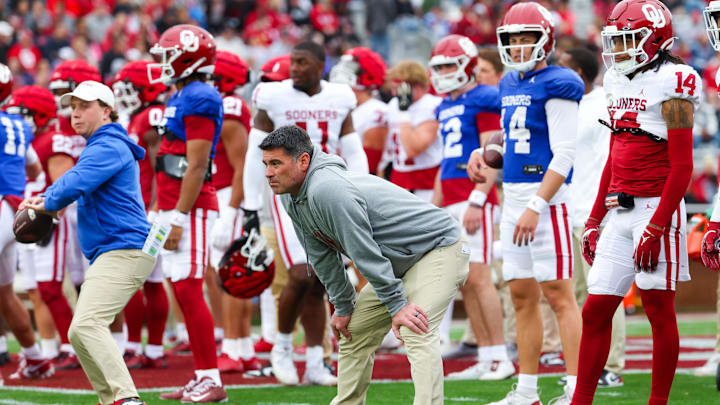Now-Mississippi State head coach Jeff Lebby has been in charge of the Oklahoma offense for the past two years. His offense, captained by now-Oregon quarterback Dillon Gabriel, was a top offense across the country for the past two years. In 2022, Oklahoma's offense ranked 13th overall and scored 32.8 points per game in 2022. In 2023, Oklahoma's offense ranked 3rd nationally and scored 41.7 points per game. Although much of Sooner Nation was obviously frustrated with many of Lebby's situational decisions, one thing is for sure; he was an excellent offensive coordinator.
Now, Seth Littrell and Sooner sophomore quarterback Jackson Arnold command the Sooners offense. Arnold has the talent, potential, and ability to lead an air raid attack. So, let's look at what we can expect from a Littrell air raid attack.
Littrell's first offensive coordinator job was in Arizona during the Mike Stoops era. His first season calling the plays was in 2010 as a co-coordinator. In total, Littrell spent 2 seasons in Arizona, 2 seasons in Indiana, and 2 seasons in North Carolina as an offensive coordinator. In 2016, Littrell was hired as the head coach for North Texas, where he had former Texas Tech quarterback Graham Harrell as his offensive coordinator.
Here is a summary of Littrell's offensive rankings:
Year | Pass Yards | Rush Yards | Scoring Avg. | NCAA Rank | Conf. Rank | Avg. Time of Posess |
|---|---|---|---|---|---|---|
2010 Arz. | 4000 | 1712 | 28.1 | 24 | 3 | 30:32 |
2011 Arz. | 4449 | 1134 | 30.8 | 16 | 3 | 30:12 |
2012 IU | 3734 | 1517 | 30.8 | 34 | 2 | 26:00 |
2013 IU | 3680 | 2422 | 38.4 | 10 | 2 | 25:13 |
2014 UNC | 3614 | 1973 | 32.8 | 48 | 5 | 25:15 |
2015 UNC | 3675 | 3142 | 40.7 | 18 | 2 | 24:48 |
2016 UNT | 2708 | 1736 | 24.8 | 117 | 13-last | 26:59 |
2017 UNT | 4086 | 2280 | 35.4 | 24 | 2 | 29:35 |
2018 UNT | 3988 | 1999 | 34.6 | 20 | 2 | 31:17 |
2019 UNT | 3400 | 1623 | 30.6 | 54 | 3 | 27:44 |
2020 UNT | 2830 | 2302 | 34.4 | 8 | 1 | 25:41 |
2021 UNT | 2562 | 3042 | 27.5 | 39 | 4 | 30:03 |
2022 UNT | 3667 | 2798 | 33.8 | 21 | 3 | 27:21 |
The first thing you'll notice is Littrell's second-year improvements. Littrell's offense made massive second-season improvements in all four destinations in every category. This is a typical trend in college football due to the schematics of an offense being difficult to cement early. However, the numbers are clear that it has almost immediate positive results once the scheme is learned.
The second point, and a significant component of the air raid's attack, is that in every year but one, Littrell's offense had significantly more passing yards than rushing yards. Of the years where Littrell was the offensive coordinator and not the head coach, his offenses averaged 3,858 passing yards and 26.6 points per game. Finally, in 4 out of Littrell's 6 seasons as an offensive coordinator, his offenses finished inside the top 10 nationally for total offense.
The Sooners' potential offensive roster is the most talented Littrell has had to work with to date. Jackson Arnold will be his most talented and arm-talent-rich passer yet. The receiving corps features big bodies (Anderson & Gibson), speedy slot receivers (Thompson & Pettaway), and deep threats (Farooq & Burks). The Sooner running back room will also contribute heavily in the passing game.
Littrell's version of the air raid will typically feature a traditional four-receiver/1-back set. With four receivers on the field simultaneously, it will be most logical to see the bigger two receivers lineup on the outside of the formation, with the speedsters Burks, Farooq, Pettaway, and Thompson featured underneath.
Mix Jackson Arnold's arm talent with the depth of the receiving and running back corps, and there is a high possibility that this Sooners offense will be ranked near the top of the SEC in total offense. The question lies in the offensive line.
Offensive lines in the air raid system utilize wider (2-3 yard) splits between players to increase the distance rushers have to travel to get to the quarterback. This distance, combined with quick-release routes, talented receivers, Arnold's quick-release, and talented blocking backs, is the primary reason why I am not as concerned about the potential O-line lineup as others.
These players are there, the potential is there, and most importantly, the history is there. Sooner Nation has high hopes for this year's offense. I don't think those hopes are too far-fetched.
